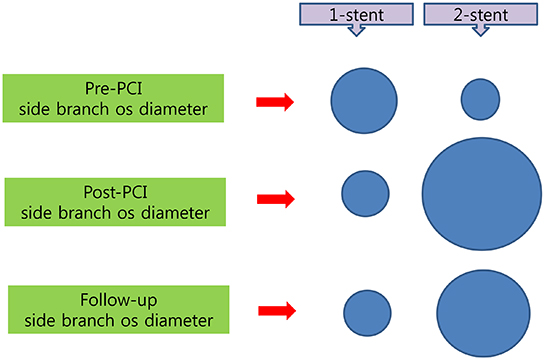1. Lefèvre T, Louvard Y, Morice MC, Dumas P, Loubeyre C, Benslimane A, Premchand RK, Guillard N, Piéchaud JF. Stenting of bifurcation lesions: classification, treatments, and results. Catheter Cardiovasc Interv. 2000; 49:274–283.
2. Myler RK, Shaw RE, Stertzer SH, Hecht HS, Ryan C, Rosenblum J, Cumberland DC, Murphy MC, Hansell HN, Hidalgo B. Lesion morphology and coronary angioplasty: current experience and analysis. J Am Coll Cardiol. 1992; 19:1641–1652.
3. Pan M, Suárez de Lezo J, Medina A, Romero M, Hernández E, Segura J, Castroviejo JR, Pavlovic D, Melian F, Ramírez A, et al. Simple and complex stent strategies for bifurcated coronary arterial stenosis involving the side branch origin. Am J Cardiol. 1999; 83:1320–1325.
4. Shin DH, Park KW, Koo BK, Oh IY, Seo JB, Gwon HC, Jeong MH, Seong IW, Rha SW, Yang JY, et al. Comparing two-stent strategies for bifurcation coronary lesions: which vessel should be stented first, the main vessel or the side branch? J Korean Med Sci. 2011; 26:1031–1040.
5. Yamashita T, Nishida T, Adamian MG, Briguori C, Vaghetti M, Corvaja N, Albiero R, Finci L, Di Mario C, Tobis JM, et al. Bifurcation lesions: two stents versus one stent--immediate and follow-up results. J Am Coll Cardiol. 2000; 35:1145–1151.
6. Melikian N, Di Mario C. Treatment of bifurcation coronary lesions: a review of current techniques and outcome. J Interv Cardiol. 2003; 16:507–513.
7. Ge L, Airoldi F, Iakovou I, Cosgrave J, Michev I, Sangiorgi GM, Montorfano M, Chieffo A, Carlino M, Corvaja N, et al. Clinical and angiographic outcome after implantation of drug-eluting stents in bifurcation lesions with the crush stent technique: importance of final kissing balloon post-dilation. J Am Coll Cardiol. 2005; 46:613–620.
8. Colombo A, Moses JW, Morice MC, Ludwig J, Holmes DR Jr, Spanos V, Louvard Y, Desmedt B, Di Mario C, Leon MB. Randomized study to evaluate sirolimus-eluting stents implanted at coronary bifurcation lesions. Circulation. 2004; 109:1244–1249.
9. Louvard Y, Lefèvre T, Morice MC. Percutaneous coronary intervention for bifurcation coronary disease. Heart. 2004; 90:713–722.
10. Koo BK, Waseda K, Kang HJ, Kim HS, Nam CW, Hur SH, Kim JS, Choi D, Jang Y, Hahn JY, et al. Anatomic and functional evaluation of bifurcation lesions undergoing percutaneous coronary intervention. Circ Cardiovasc Interv. 2010; 3:113–119.
11. Koo BK, Kang HJ, Youn TJ, Chae IH, Choi DJ, Kim HS, Sohn DW, Oh BH, Lee MM, Park YB, et al. Physiologic assessment of jailed side branch lesions using fractional flow reserve. J Am Coll Cardiol. 2005; 46:633–637.
12. Pan M, de Lezo JS, Medina A, Romero M, Segura J, Pavlovic D, Delgado A, Ojeda S, Melián F, Herrador J, et al. Rapamycin-eluting stents for the treatment of bifurcated coronary lesions: a randomized comparison of a simple versus complex strategy. Am Heart J. 2004; 148:857–864.
13. Steigen TK, Maeng M, Wiseth R, Erglis A, Kumsars I, Narbute I, Gunnes P, Mannsverk J, Meyerdierks O, Rotevatn S, et al. Nordic PCI Study Group. Randomized study on simple versus complex stenting of coronary artery bifurcation lesions: the Nordic bifurcation study. Circulation. 2006; 114:1955–1961.
14. Ferenc M, Gick M, Kienzle RP, Bestehorn HP, Werner KD, Comberg T, Kuebler P, Büttner HJ, Neumann FJ. Randomized trial on routine vs. provisional T-stenting in the treatment of de novo coronary bifurcation lesions. Eur Heart J. 2008; 29:2859–2867.
15. Di Mario C, Morici N, Godino C, Goktekin O, Tamburino C, Barbagallo R, Antoniucci D, Grube E, Airoldi F, Zoccai GB, et al. Predictors of restenosis after treatment of bifurcational lesions with paclitaxel eluting stents: a multicenter prospective registry of 150 consecutive patients. Catheter Cardiovasc Interv. 2007; 69:416–424.
16. Sharma SK, Kini AS. Coronary bifurcation lesions. Cardiol Clin. 2006; 24:233–246. vi
17. Hoye A, van Mieghem CA, Ong AT, Aoki J, Rodriguez Granillo GA, Valgimigli M, Tsuchida K, Sianos G, McFadden EP, van der Giessen WJ, et al. Percutaneous therapy of bifurcation lesions with drug-eluting stent implantation: the Culotte technique revisited. Int J Cardiovasc Intervent. 2005; 7:36–40.
18. Gao Z, Yang YJ, Gao RL. Comparative study of simple versus complex stenting of coronary artery bifurcation lesions in daily practice in Chinese patients. Clin Cardiol. 2008; 31:317–322.
19. Topol EJ, Nissen SE. Our preoccupation with coronary luminology: the dissociation between clinical and angiographic findings in ischemic heart disease. Circulation. 1995; 92:2333–2342.
20. Gao XF, Zhang YJ, Tian NL, Wu W, Li MH, Bourantas CV, Jiang XM, Wang ZM, Li B, Mao WX, et al. Stenting strategy for coronary artery bifurcation with drug-eluting stents: a meta-analysis of nine randomised trials and systematic review. EuroIntervention. 2014; 10:561–569.
21. Niemelä M, Kervinen K, Erglis A, Holm NR, Maeng M, Christiansen EH, Kumsars I, Jegere S, Dombrovskis A, Gunnes P, et al. Nordic-Baltic PCI Study Group. Randomized comparison of final kissing balloon dilatation versus no final kissing balloon dilatation in patients with coronary bifurcation lesions treated with main vessel stenting: the Nordic-Baltic Bifurcation Study III. Circulation. 2011; 123:79–86.










 PDF
PDF ePub
ePub Citation
Citation Print
Print




 XML Download
XML Download